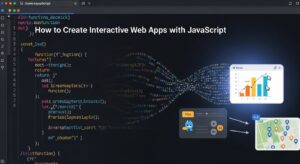Building React single page applications has become the cornerstone of modern web development, transforming how users interact with web interfaces. Whether you’re starting your React journey or looking to deepen your SPA expertise, this comprehensive guide will walk you through the essential concepts and practical implementation strategies.
What Makes React Single Page Applications So Powerful?
Before we dive into the technical implementation, let’s explore what sets React SPAs apart from traditional multi-page applications. A React single page application loads a single HTML page and dynamically updates content as users navigate, creating seamless, app-like experiences without full page refreshes.
Key Benefits of React SPAs:
- Lightning-fast navigation between views
- Reduced server load through client-side rendering
- Enhanced user experience with smooth transitions
- Offline capabilities when combined with service workers
- Mobile-responsive performance optimization
Foundation: Setting Up Your React Single Page Application Environment
Let’s start by establishing your development environment. What’s your current experience level with React and modern JavaScript tooling?
Essential Tools and Dependencies
npx create-react-app my-spa-project
cd my-spa-project
npm install react-router-dom axios
This command creates a robust foundation for your React single page application with all necessary build tools configured automatically.
Project Structure Best Practices
src/
components/
common/
pages/
hooks/
services/
styles/
utils/
App.js
index.js
Step 1: Implementing Client-Side Routing in Your React Single Page Application
Client-side routing forms the backbone of any effective React single page application. React Router provides the navigation infrastructure without server requests.
Basic Routing Setup
import { BrowserRouter as Router, Routes, Route } from 'react-router-dom';
import HomePage from './components/pages/HomePage';
import AboutPage from './components/pages/AboutPage';
import ContactPage from './components/pages/ContactPage';
function App() {
return (
<Router>
<div className="App">
<Routes>
<Route path="/" element={<HomePage />} />
<Route path="/about" element={<AboutPage />} />
<Route path="/contact" element={<ContactPage />} />
</Routes>
</div>
</Router>
);
}
Advanced Routing Patterns
Routing Pattern | Use Case | Implementation |
Dynamic Routes | User profiles, product pages | /user/:id |
Nested Routes | Dashboard sections | <Route path=”/dashboard/*”> |
Protected Routes | Authentication required | Custom wrapper component |
Lazy Loading | Code splitting | React.lazy() with Suspense |
Consider how these patterns might apply to your specific application needs. What type of navigation structure best serves your users?
Step 2: State Management Strategies for React SPAs
Effective state management distinguishes professional React single page applications from basic implementations. Let’s explore different approaches based on application complexity.
Context API for Medium Complexity
import { createContext, useContext, useReducer } from 'react';
const AppContext = createContext();
export const useAppState = () => {
const context = useContext(AppContext);
if (!context) {
throw new Error('useAppState must be used within AppProvider');
}
return context;
};
export const AppProvider = ({ children }) => {
const [state, dispatch] = useReducer(appReducer, initialState);
return (
<AppContext.Provider value={{ state, dispatch }}>
{children}
</AppContext.Provider>
);
};
When to Consider Redux or Zustand
For larger React single page applications, consider these scenarios:
- Multiple team members working on different features
- Complex data flows between distant components
- Time-travel debugging requirements
- Middleware needs for logging or persistence
External resource: Redux Toolkit Official Guide
Step 3: API Integration and Data Fetching Patterns
Modern React single page applications rely heavily on API interactions. Let’s implement robust data fetching strategies that enhance user experience.
Custom Hook for API Calls
import { useState, useEffect } from 'react';
import axios from 'axios';
export const useApiData = (url) => {
const [data, setData] = useState(null);
const [loading, setLoading] = useState(true);
const [error, setError] = useState(null);
useEffect(() => {
const fetchData = async () => {
try {
setLoading(true);
const response = await axios.get(url);
setData(response.data);
} catch (err) {
setError(err.message);
} finally {
setLoading(false);
}
};
fetchData();
}, [url]);
return { data, loading, error };
};
Implementing Error Boundaries
Error boundaries protect your React single page application from JavaScript errors that could crash the entire interface:
class ErrorBoundary extends React.Component {
constructor(props) {
super(props);
this.state = { hasError: false };
}
static getDerivedStateFromError(error) {
return { hasError: true };
}
componentDidCatch(error, errorInfo) {
console.log('Error caught by boundary:', error, errorInfo);
}
render() {
if (this.state.hasError) {
return <h1>Something went wrong. Please try again later.</h1>;
}
return this.props.children;
}
}
Step 4: Performance Optimization Techniques
Performance optimization transforms good React single page applications into exceptional user experiences. Let’s implement key strategies that measurably improve loading times and responsiveness.
Code Splitting with React.lazy()
import { Suspense, lazy } from 'react';
const LazyComponent = lazy(() => import('./components/ExpensiveComponent'));
function App() {
return (
<div>
<Suspense fallback={<div>Loading...</div>}>
<LazyComponent />
</Suspense>
</div>
);
}
Memoization Strategies
import { memo, useMemo, useCallback } from 'react';
const ExpensiveComponent = memo(({ data, onUpdate }) => {
const processedData = useMemo(() => {
return data.map(item => ({
...item,
processed: expensiveCalculation(item)
}));
}, [data]);
const handleUpdate = useCallback((id) => {
onUpdate(id);
}, [onUpdate]);
return (
<div>
{processedData.map(item => (
<div key={item.id} onClick={() => handleUpdate(item.id)}>
{item.name}
</div>
))}
</div>
);
});
How might these optimization techniques apply to the most resource-intensive parts of your application?
Step 5: Building and Deployment Best Practices
The final step transforms your React single page application from development code into a production-ready system that serves users efficiently.
Production Build Optimization
npm run build
npm install -g serve
serve -s build
Essential Deployment Configurations
Configure your web server to handle SPA routing properly:
Apache (.htaccess):
Options -MultiViews
RewriteEngine On
RewriteCond %{REQUEST_FILENAME} !-f
RewriteRule ^ index.html [QSA,L]
Nginx:
location / {
try_files $uri $uri/ /index.html;
}
Performance Monitoring
Implement monitoring to track your React single page application performance in production:
// Web Vitals tracking
import { getCLS, getFID, getFCP, getLCP, getTTFB } from 'web-vitals';
getCLS(console.log);
getFID(console.log);
getFCP(console.log);
getLCP(console.log);
getTTFB(console.log);
Advanced Patterns and Considerations
SEO Optimization for React SPAs
While React single page applications traditionally face SEO challenges, modern solutions provide excellent search engine visibility:
- Server-Side Rendering (SSR) with Next.js
- Static Site Generation (SSG) for content-heavy sites
- React Helmet for dynamic meta tags
- Prerendering services for existing SPAs
Security Best Practices
Security Concern | Implementation Strategy |
XSS Prevention | Sanitize user inputs, use dangerously Set Inner HTML carefully |
CSRF Protection | Implement CSRF tokens for state-changing operations |
Authentication | Use secure token storage (http Only cookies) |
Data Validation | Validate both client and server-side |
Testing Strategies
Comprehensive testing ensures your React single page application remains reliable as it grows:
import { render, screen, fireEvent } from '@testing-library/react';
import { BrowserRouter } from 'react-router-dom';
import App from './App';
test('navigates to about page', () => {
render(
<BrowserRouter>
<App />
</BrowserRouter>
);
fireEvent.click(screen.getByText(/about/i));
expect(screen.getByText(/about page content/i)).toBeInTheDocument();
});
Common Pitfalls and Solutions
Memory Leaks Prevention
useEffect(() => {
const subscription = apiService.subscribe(data => {
setData(data);
});
return () => {
subscription.unsubscribe(); // Always cleanup subscriptions
};
}, []);
Bundle Size Management
Monitor and optimize your bundle size regularly:
npm install --save-dev webpack-bundle-analyzer
npm run build
npx webpack-bundle-analyzer build/static/js/*.js
Conclusion: Mastering React Single Page Application Development
Building effective React single page applications requires mastering multiple interconnected concepts: routing, state management, API integration, performance optimization, and deployment strategies. Each piece contributes to creating seamless user experiences that rival native applications.
The key to success lies in understanding when to apply specific patterns and optimizations. Start with a solid foundation using the techniques outlined above, then gradually implement advanced patterns as your application’s complexity grows.











